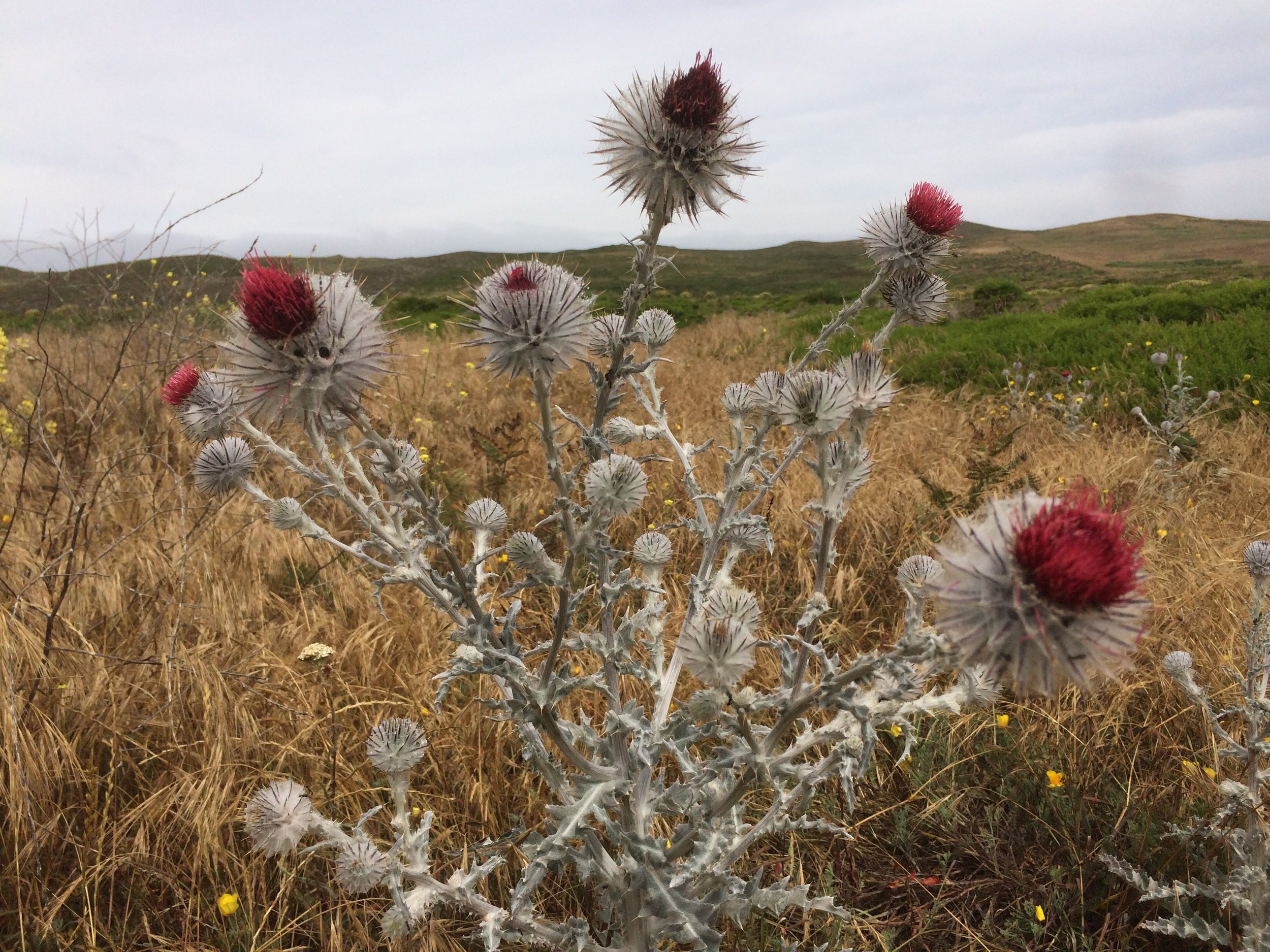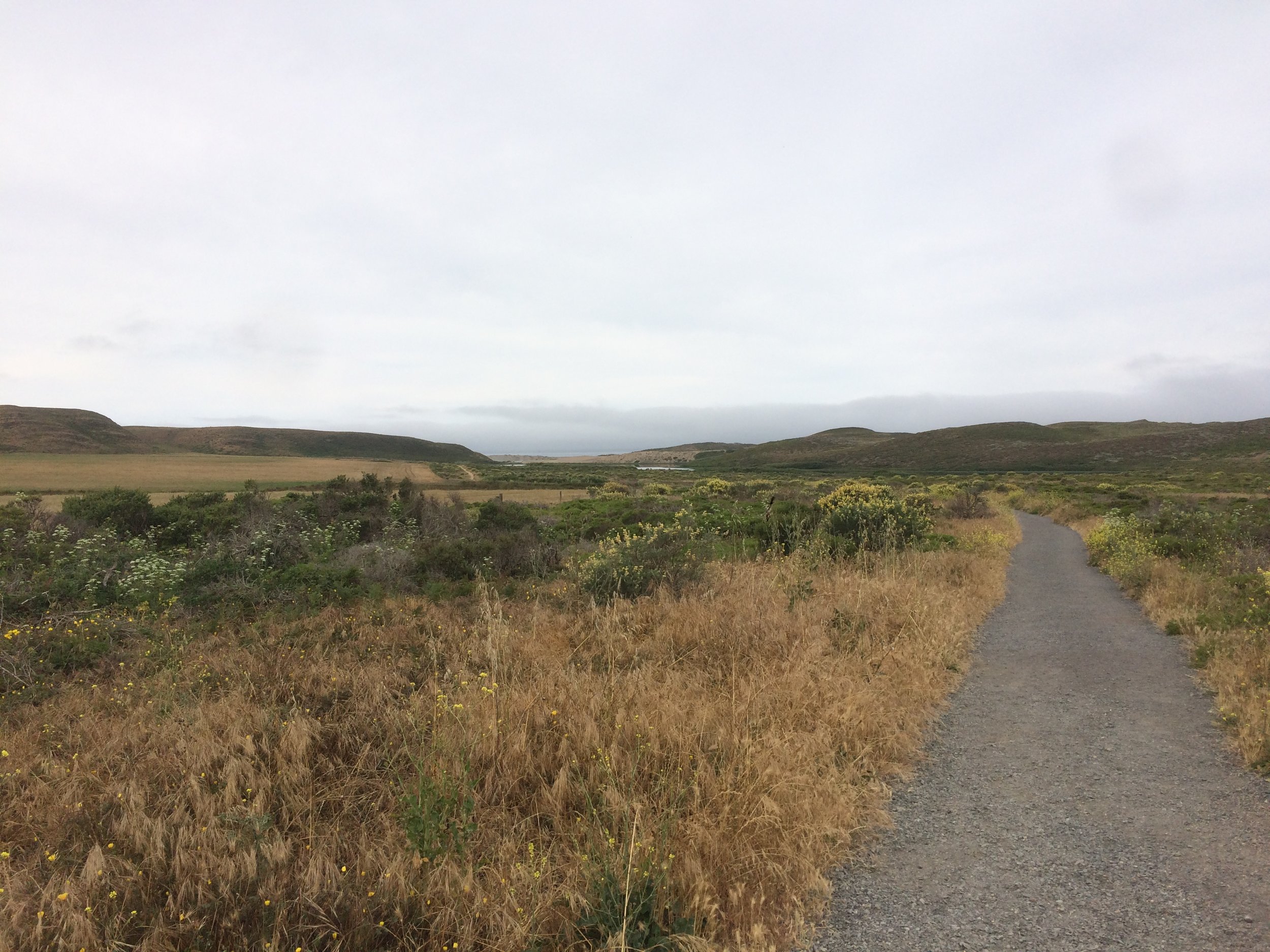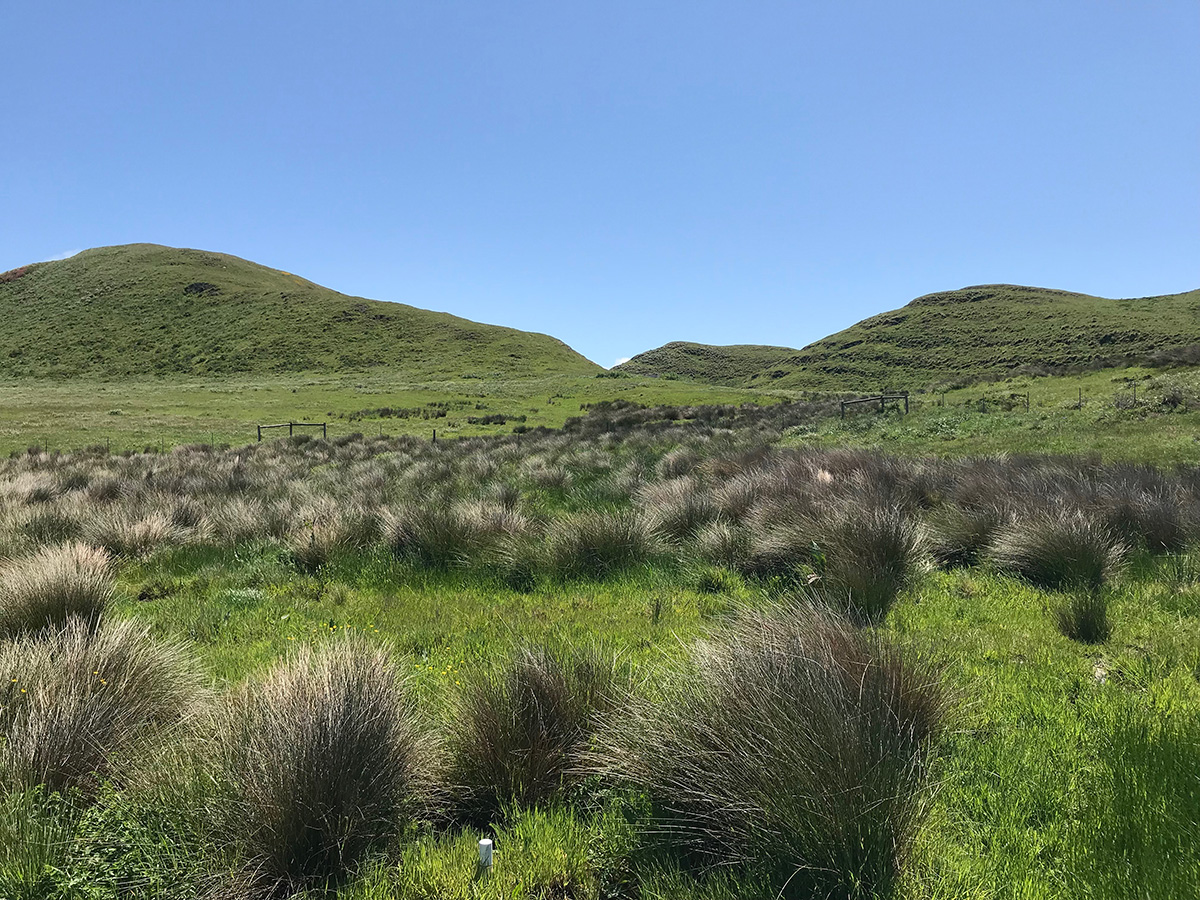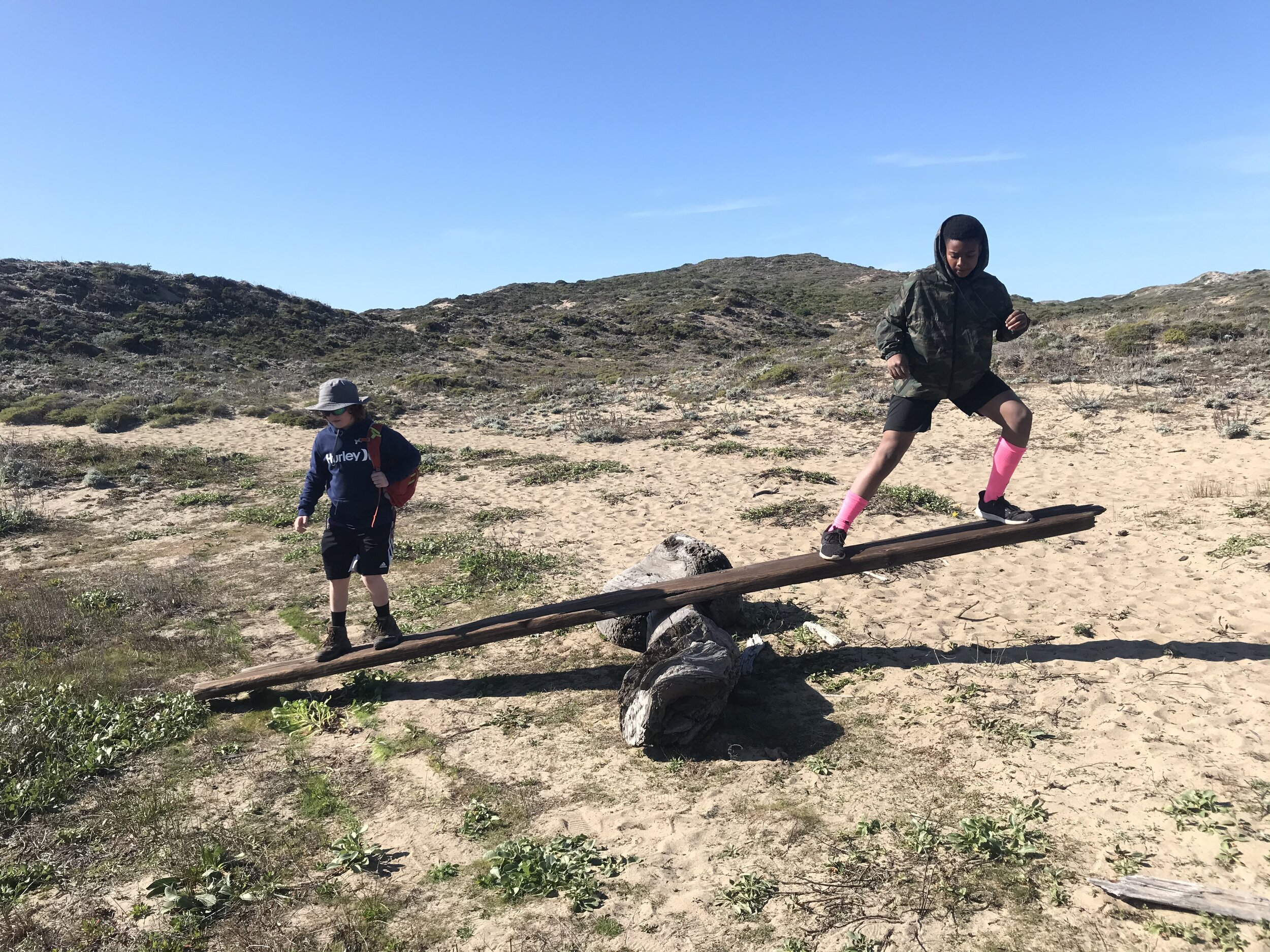Abbotts Lagoon Trail
Trail length: 3.0 miles, out and back (1.1 miles to the bridge and 0.4 miles to the ocean each way)
Time: 45-60 minutes each way at a leisurely pace
Terrain: coast chaparral, marsh, lagoon, beach, dunes
Restroom? Yes, at the trailhead
Parking: large parking lot
Kid friendly? Yes, it's a flat, easy hike with a log seesaw
Dates visited: 11/8/14, 3/1/15, 6/4/16, 7/17/16, 1/29/17, 6/15/17, 8/16/17, 2/24/18, 4/29/18, 10/6/18, 1/3/19, 6/4/19, 6/27/19, 7/28/19, 8/31/19, 10/14/19, 2/23/20, 8/9/20, 11/29/20
Favorite plants on this trail: Cobwebby thistle
Plant lists from the Marin chapter of California Native Plant Society:
Favorite spots:
On top of the cliff overlooking the lagoon and ocean in the distance,
Sitting in front of the log that makes a wind break. it's across the lagoon from the cliff.
Looking for plants on the marshy edges of the wood boardwalk.
This is my go-to hiking trail. The varied terrain makes for an abundance of birds, plants, insects, and even river otters. You'll encounter shorebirds at the beach, egrets, herons, and migratory birds at the lagoon, and friendly sparrows in the brambles and perched along the fence of the pasture. The pasture is particularly active. In addition to regular grazing cows and deer, I've seen a bobcat on the hillside, a burrowing owl, and a Great Blue Heron hunting (successfully). Cobwebby thistle can be found along the beginning of the trail. The predominant color of flowers is yellow: Yellow Bush Lupine, Coast Tarweed, and Shortpod Mustard along the trail, California Goldenbush, Muskflower and Seep Monkeyflower in the marshy wet areas, Seaside Woolly Sunflower covering the cliff tops, Yellow Sand Verbena, Beach Suncup and Gumplant in the sandy dunes, I have been wondering if my observation about the dominance of yellow flowers is accurate, and if so, what makes yellow so successful here? If you have a theory, please let me know.
It's often cooler here than in Inverness or Point Reyes Station, so this is a great hike on a rare scorching day at the Seashore. The beach is windblown, cold, and basically inhospitable; however, the dunes are a wonderfully diverse place to explore and they offer some relief from the chill ocean winds.
Where does the water come from in Abbotts Lagoon? According to park biologist Matt Lau, it's a mix of rainwater, groundwater, and ocean water! The lower lagoon will usually break open out into the ocean during the winter, letting a rush of hypersaline water into the lagoon system. During rainy years, the lagoon will often fill up as well. This means the lagoon is brackish (partially salt water and partially freshwater).
If you look up the hill toward the North, you can see Historic I Ranch, a dairy ranch operated by the McClure family from 1939 to 2021.
Surprisingly, from 1941 to 1952, Abbotts Lagoon was used as a practice bombing target (no explosives were used.) I can imagine the cows and wildlife were not too happy about that.
Point Reyes historic ranches maps
How did Abbotts Lagoon get its name?
Abbotts Lagoon is named for John and Carlisle Abbott, two brothers born in Canada who leased the historic H & I dairy ranches in 1858. Carlisle Abbott (1828-1919) wrote an autobiography, Recollections of a California Pioneer, when he was 88 years old. He briefly talked about his time in Point Reyes (see below, chapter XVIII, pages 151-154), including mention of grizzly bears and cinnamon bears that preyed on the "very wild" Spanish cattle in the area. Shortly after he arrived at H ranch, he helped rescue men from the shipwreck of the Sea Nymph, one of many shipwrecks in the area. He lived in Point Reyes until 1865 then moved to Salinas Valley in Monterey County to continue dairy ranching.
Point Reyes Prince Beetle aka the Coyote Brush Leaf Beetle (Trirhabda flavolimbata)
The timing was perfect to encounter multitudes of beetles filling the Coyote Brush at Abbotts Lagoon on July 28, 2019. Jim Rolka, a long-time docent and volunteer has dubbed this beetle the Point Reyes Prince Beetle. Reyes means king in Spanish so clearly this beetle must be a prince. It’s iridescent teal wings form a cloak and its gold necklace is studded with black jewels — obvious signs of royalty. There were at least 100 beetles on a single Coyote Brush. Depending on the light, their color ranges from emerald green to sapphire blue.
A rare flower
Sonoma spineflower Photo by Doreen Smith
Abbotts Lagoon is the location of the single remaining natural population of the endangered plant species Sonoma spineflower (Chorizanthe valida), a rare species of flowering plant in the buckwheat family. Endemic to West Marin, it was thought to be extinct until 1980 when the Point Reyes population was discovered. (Wikipedia)
Volunteer Opportunity: Snowy Plover Docent
Educate visitors about the threatened Western Snowy Plovers during nesting season from Memorial Day to Labor Day. Docents staff an information table at a trailhead or on the beach and walk the trail and beach informing visitors about Snowy Plovers.


































































![Historic_alphabet_designations_of_Point_Reyes_Ranches,_1860–1990By Dewey Livingston, Point Reyes National Seashore [Public domain], via Wikimedia Commons.jpg](https://images.squarespace-cdn.com/content/v1/5958426229687faf8787d415/1524799969244-4FU7CXUWWS6N2YNGHIBV/Historic_alphabet_designations_of_Point_Reyes_Ranches%2C_1860%E2%80%931990By+Dewey+Livingston%2C+Point+Reyes+National+Seashore+%5BPublic+domain%5D%2C+via+Wikimedia+Commons.jpg)










